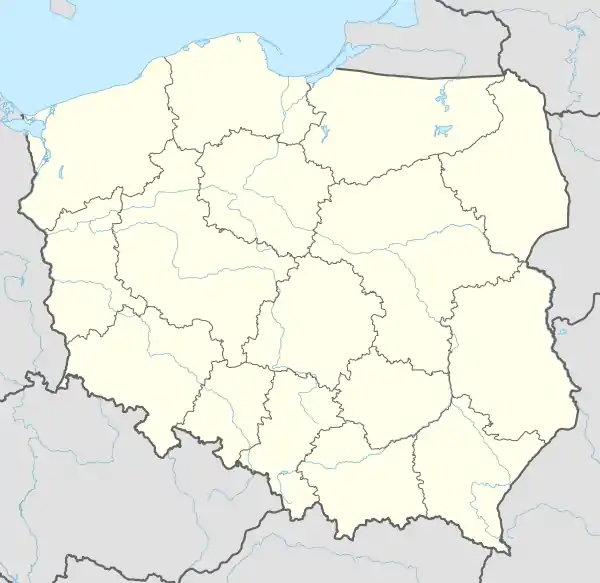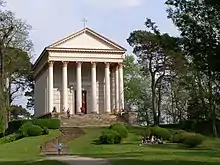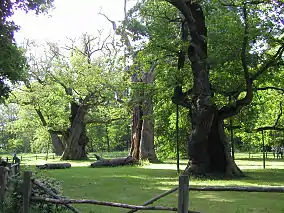Rogalin
Rogalin pronounced [rɔˈɡalin] is a village in western Poland, situated on the river Warta. It lies approximately 7 kilometres (4 mi) east of the town of Mosina, and 19 km (12 mi) south of the metropolitan city of Poznań.[1] It is perhaps best known for the Rogalin Landscape Park and its oak trees.
Rogalin | |
|---|---|
Village | |
.jpg.webp) Palace in Rogalin | |
 Rogalin | |
| Coordinates: 52°14′04″N 16°56′04″E | |
| Country | |
| Voivodeship | Greater Poland |
| County | Poznań County |
| Gmina | Mosina |
| Population (approx.) | 700 |
Overview
Rogalin is primarily famous for its 18th-century Polish Baroque palace of the Raczyński family, and the adjacent Raczyński Art Gallery, housing a permanent exhibition of paintings by the Polish and foreign artists of international renown including Paul Delaroche and Claude Monet as well as the famous Jan Matejko's large-size painting Joanna d'Arc (see a fragment below). The gallery was founded by Count Edward Aleksander Raczyński. Rogalin is also known for its putatively 1000-year-old oak trees (Polish: Dęby Rogalińskie) on the flood plains of the Warta and the historical St. Marcellinus Church, whose design was inspired by the Roman temple Maison Carrée in Nîmes, France.

The last owner of the estate was Count Edward Bernard Raczyński, who in 1979–1986 was President of the Polish Republic in exile. His sarcophagus is deposited in the Raczyński Mausoleum, under the church in Rogalin. In his testament, Count Raczyński bequeathed his estate in Rogalin (including the family palace, gallery, library, and church) to the Raczyński Family Foundation (its president is the Director of the National Museum in Poznań[2].
Geography
Much of the surrounding landscape forms the protected area of recognized natural and ecological value known as the Rogalin Landscape Park.
 Palace in Rogalin - front view
Palace in Rogalin - front view An aerial view of the palace
An aerial view of the palace The library
The library Sarcophagus of Count Edward Bernard Raczyński
Sarcophagus of Count Edward Bernard Raczyński Statue in Rogalin Park
Statue in Rogalin Park Rogalin Oaks
Rogalin Oaks Joanna d`Arc, fragment of large-scale painting by Jan Matejko of 1886
Joanna d`Arc, fragment of large-scale painting by Jan Matejko of 1886 Portrait of Edward Aleksander Raczyński by Jacek Malczewski
Portrait of Edward Aleksander Raczyński by Jacek Malczewski A paintings gallery in the palace
A paintings gallery in the palace Interior of the palace
Interior of the palace A historic fireplace
A historic fireplace.jpg.webp) General view of the Rogalin Palace
General view of the Rogalin Palace
References
- Information for tourists and citizens at Rogalin.org
- "Fundacja Raczyńskich | Majątek Rogalin". fundacjaraczynskich.pl. Retrieved 2020-02-17.
- Adam Wyszynski, Photos from Rogalin at Rogalin.eu
External links
 Rogalin travel guide from Wikivoyage
Rogalin travel guide from Wikivoyage

